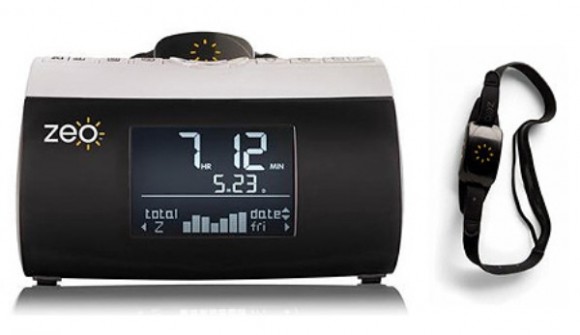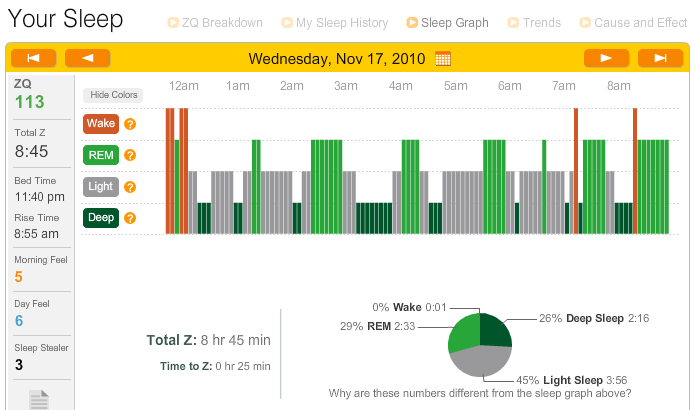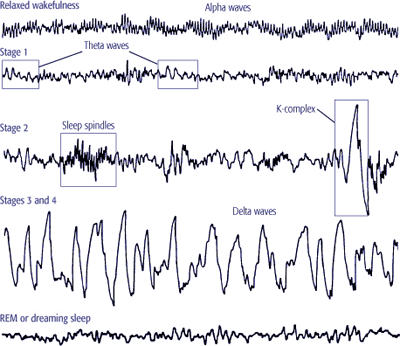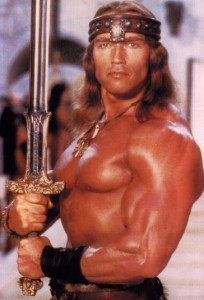
One of my core values for this site is integrating the old ways with the new. Dreaming and imagination studies are the most ancient of human cognitive achievements, and I love exploring how these abilities can be studied—and even enhanced—with modern technology and 21st century methods of data analysis.
So I was pretty pleased when my Zeo came in the mail: a device that tracks your sleep and provides insight into how to get better rest. This post is a product review and to be completely transparent, I occasionally consult with Zeo as a dream researcher and I received the device as a gift. I want to share how I’m using Zeo and some of the possibilities of this technology for dream tracking and lucid dreaming incubation too.

Let’s get right to it. Above is a night of my sleep as recorded by Zeo, a smart alarm that retails at about $200. Yeah, I usually sleep in until about 9am. I dream professionally, after all. So the readout tells me how long it took me to get to sleep (13 minutes), and how much time I spent in the major phases of sleep: light, deep and REM. The red marks are awakenings.
The only other sleep device I’ve explored is Hobson’s Nightcap, the first “home sleep lab,” which was designed to track sleep stages and micro-awakenings. You had to stick a sensor directly on your eyelid – not comfortable– wear a clunky headband and tether yourself to a wired device in bed. That device was amazing though because for the first time sleepers could take the data to their sleep doctor and not have to spend a night in the lab to determine if they suffer from sleep apnea.
How Zeo Works
Zeo is not sold as a medical device but it actually provides more detail about sleep than Hobson’s device ever dreamed of. The main sensors are embedded in a headband and placed against your forehead without the need for conductive liquid gel. The revolutionary technology behind it is called Softwave, which has been written up in several peer-reviewed sleep journals as having the same range of accuracy as standard sleep lab polysomnography. The sensors measure the electrical output of the frontal lobe of the brain, specifically a range between 2 – 50hz.

Like Hobson’s device, the headband also measures head and neck movement to help distinguish between REM and awakening. But Zeo’s data is then wirelessly transmitted by the headband to the main device, the Zeo personal sleep coach. The data is stored on the device and also on a 2GB memory card card, which you can then upload via USB adaptor to the Zeo site to parse the data into sleep stages.
Discover how well you really sleep
Over time, you can see patterns about how you sleep, as well as what factors are disturbing your sleep. You could also experiment with alternative sleep styles, such as polyphasic sleeping, to determine the healthiest and most efficient sleeping method for you. (There’s no hard and fast rule that humans are supposed to sleep 8 hours straight, after all. That’s an artifact of industrialization.)
In short, Zeo makes your bedroom into a home sleep lab.
You may be interested in the scientific validations behind Zeo – I know I was. Here’s the link to the peer-reviewed science behind Zeo, conducted by Harvard sleep doctors.
SmartWake makes waking up easier
One extraordinary feature is the SmartWake alarm, which uses the real-time brain activity to determine the best time to wake you up (close to your preferred time). The alarm goes off when you transition from light sleep into REM or from REM to light sleep, a time when the brain is highly activated. When I wake up from REM, I’m alert and jump out of bed. When I wake up from the middle of light or deep sleep (which actually can both be pretty “deep” in terms of brain activity), I am sluggish and more likely to say “Where’s my coffee?”
Open Source Data

Maybe now you understand why I’m so excited about the potential of Zeo — not only for personal use but for empowering the next generation of sleep and dream researchers. Recently, Zeo went open-source, meaning that users can download the raw data files and hopefully develop new applications. Already, one user has devised a system using so you can look at your brain activity on a computer monitor in real time without uploading it to the server first.
So now Zeo is a biofeedback machine, too. This is pretty radical.
They’ve also just teamed up with Digifit, a company that specialized in iPhone apps for athletes that track your cardio, weight monitoring, caloric output and, now, sleep fitness.
My experiences and reservations

I’ve tested my Zeo for over three weeks now. The main result is I’m re-energized about my sleep health. I’ve cut down my caffeine intake and watched my deep sleep time almost double. I’m more conscious about drinking alcohol within 3 hours of bed too, because it appears to increase my awakenings and possibly suppress my REM for the first half of the night (need more data to be sure tho).
But I also have been looking for inconsistencies and Zeo does make mistakes. For example, my wife gets up for work every morning at 6am and I usually remember waking up to her alarm, as well as when she says goodbye to me about an hour later. Often I wake up multiple times during this hour, and Zeo will fail to record these awakenings.
I read up on this and discovered that awakenings less than 2 minutes aren’t recorded by Zeo. Why? Because the REM/sleep awakening transition is notoriously difficult to pin down, even for classic polysomnography. Dreaming sleep electrical output can be hard to distinguish from laying in bed when you’re quietly thinking about your dreams… which is interesting from a philosophical perspective but not very practical. In sleep labs, a technician augments the electrical data with observation as well as the sleeper’s own subjective reports.
So Zeo does not always pin down these short awakenings by itself, which is why Zeo should not be used as a medical device if you’re wondering if you have sleep apnea or another sleep disorder. (But you could bring in your sleep reports to your doctor as a self-report—many use it for this purpose).
Otherwise, using the device is easy. The headband is comfortable. It also makes me look like Conan the Barbarian.
What about radiation?
![]() I also was initially concerned about the wireless electrical output of the Zeo headband. I sometimes can get electrosensitivity symptoms, and we’ve all seen the headlines about cellphone radiation recently (if you haven’t, you should read Devra Davis’s Disconnect: The Truth About Cell Phone Radiation, What the Industry Has Done to Hide It, and How to Protect Your Family).
I also was initially concerned about the wireless electrical output of the Zeo headband. I sometimes can get electrosensitivity symptoms, and we’ve all seen the headlines about cellphone radiation recently (if you haven’t, you should read Devra Davis’s Disconnect: The Truth About Cell Phone Radiation, What the Industry Has Done to Hide It, and How to Protect Your Family).
With a little research, I discovered that the headband transmits at 24Hz on a 2.4GHz frequency band, with a max power output slightly over 1 milliwatt. This is pretty insignificant. If you have a wireless network at home and at work, you are subjected to this level of output—and greater—all the time. It’s about a thousandth of the electrical output from a cellphone or one of those new energy-efficient light bulbs.
Lucid Dreaming with Zeo

My biggest inspiration for Zeo is its promise for tracking dreams and lucid dreams. Tim Post has already written an in-depth review of how Zeo could be used as a lucid dreaming induction tool. Basically, you can set the SmartWake to about 6 hours in, wake up at the onset of REM, and then do any number of lucid dreaming techniques such as Laberge’s MILD, or a Wake-Back-To-Bed method of your choice.
You could also use it to recover more dreams by waking up and instantly pull out your dream journal. Dreams are a natural side-effect of getting better sleep, especially because when we are sleep-deprived, we tend to cut out the last and longest REM cycles of the morning. That thin line between dreaming and awakening can also help you remember more dreams by the Snooze Method.
Dream researcher Kelly Bulkeley has already logged on 350+ nights with Zeo, and is beginning to formulate his own Zeo-inspired research too.
Personally, I also am going to use Zeo to test dream supplements. Blogger Lee Adams from LucidConsciousness.com is also poised to simultaneously test with me using the similar protocols, and we’re being advised by dream supplement experts from Mortalmist.com. Our first experiment will be with 5-HTP, which has a known effect for increasing vivid dreams and lucid dreams. Now we can also find out how 5HTP use correlates with our personal sleep architectures.
Sleep nerds – unite!
Ryan, this is an AWESOME and informative review. I’ve had a ZEO for over a year and have found it really helpful in identifying my sleep stealers and blogged about it, too (http://bobbieann.net/blog1/tag/zeo/). I don’t use it on a regular basis any more, but occasionally wear it for a week or so at a time to see if there are any changes in my sleep patterns, or if I’m falling back into bad habits.
I also have to say that I am EXTREMELY jealous of how much deep sleep you get. On my best night I got 53 minutes, but usually average about 20. I’m sure that age is a big factor here.
My first thought about ZEO was that it could be modified to alert you when you are in REM to induce lucidity (with flashing lights similar to the NOVA?).
Thanks for a great review, it’s a product worth touting.
This is a very interesting article and piece of technology.
There are countless places to go with this. I like the idea of validating suppliment effect. Another area to pursue might be the whole issue of REM vs. non-REM dreaming. I’ve heard theories put forth in this regard. That non-REM dreams tend to be more like OOBE’s, or have a tendency toward washed out scenes and so forth. While it’s a tricky challenge, I think that the Zeo could be used to investigate that question. Can it be set to wake a sleeper out of light or deep sleep?
It would also be interesting to monitor brainstate during sleep paralysis episodes of course. Very interesting.
Hi Ryan! Great review. Especially learning about Zeo’s (current) inability to measure micro-awakenings. That had me thinking already (these could be great portals for WILDing) however my Zeo told me I just had about 2 – 4 about each night. Now know why 😉
Ryan,
Awesome post and thanks so much for mentioning my name and website. I cant wait to start getting some work done, but getting base lines are really a pain, especially when I am excited to start using the supplements.
I was thinking about writing a myzeo review but yours pretty much hits the spot for everything that I would even want to say. The myzeo is truly awesome and with little persuasion a few of my friends are looking into getting theirs. It may be a way of getting more people involved in the experiments too.
Thanks again!
thanks everyone. Zeo has got me inspired again about brain science, which is saying a lot as I can be pretty techno-phobic at time. Yet, I love science fiction. and shiny whirly-gigs. towards integration!